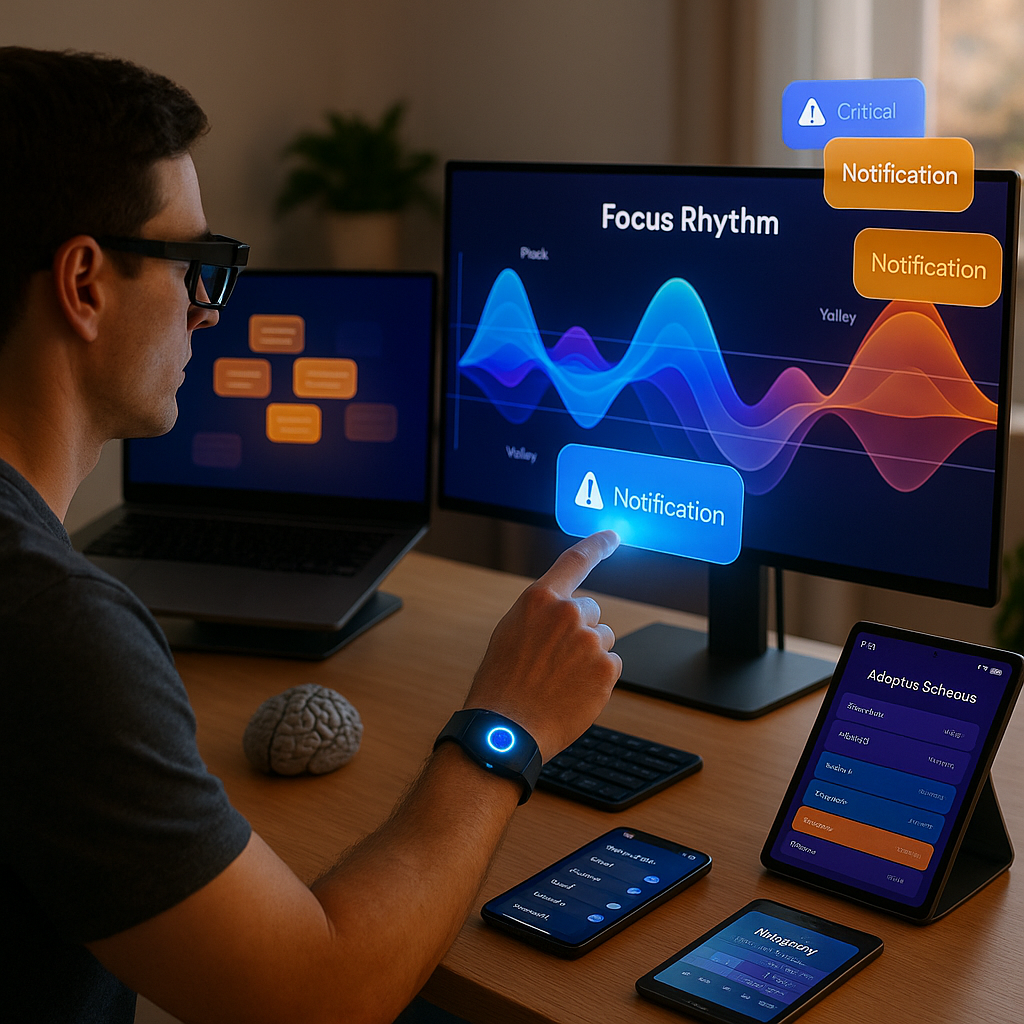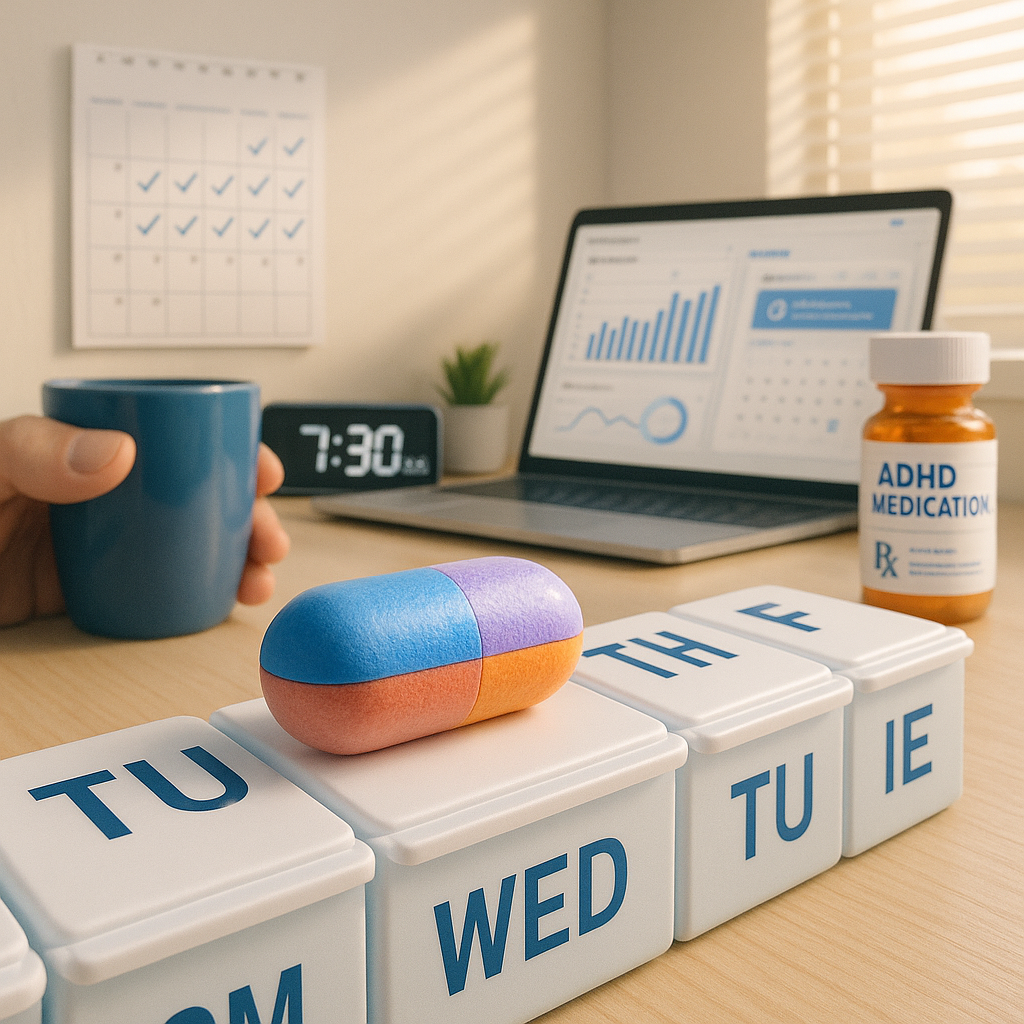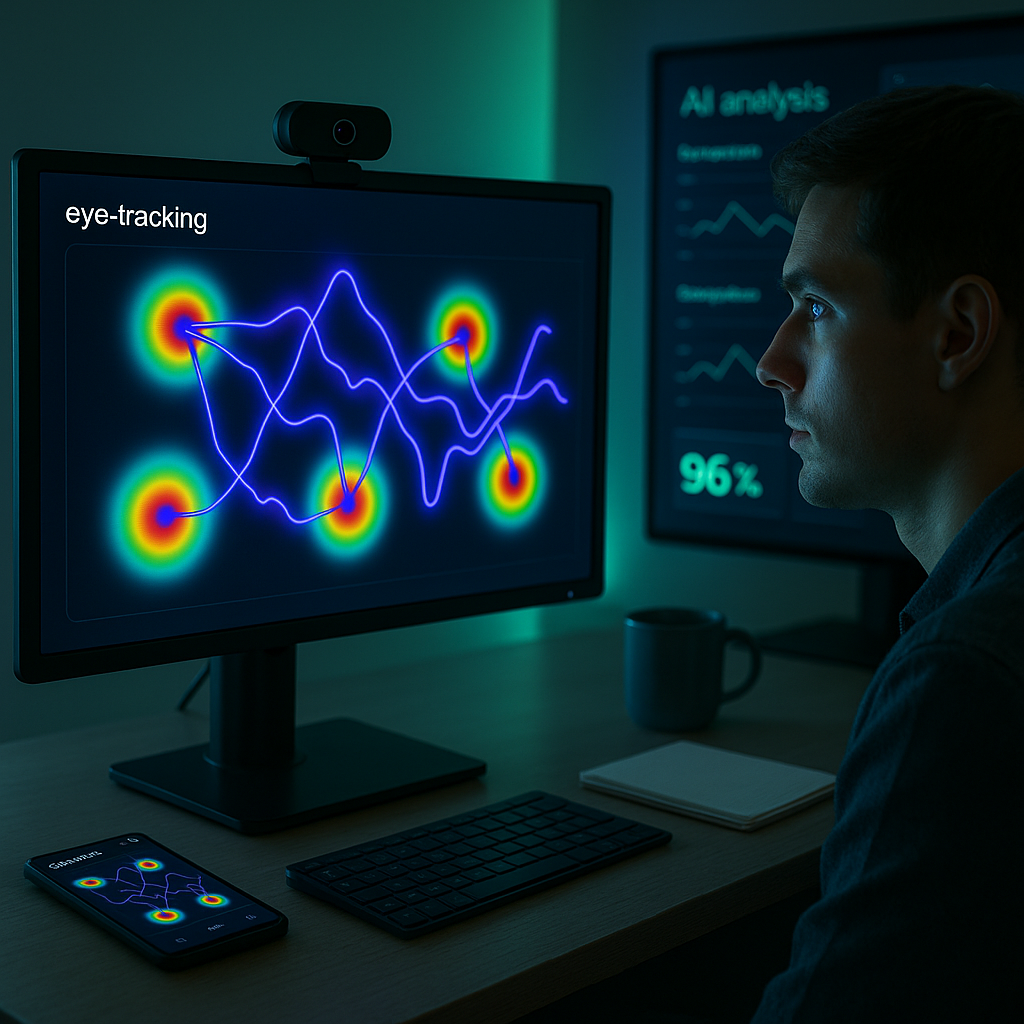Key Takeaways
Adaptive reminders are ushering in a transformative upgrade for anyone navigating the cycle of missed tasks and overwhelming notifications. This innovation is especially profound for people with ADHD and related neurodivergences, who frequently battle with static, one-size-fits-all reminders that seem to complicate rather than simplify daily life. Unlike traditional reminders that run on a fixed schedule, adaptive AI-powered systems dynamically attune to your unique focus and energy patterns, aiming to support your workflow in sync with how your mind truly operates. Here are the essential takeaways to unlock smarter, more supportive reminders designed to collaborate with your brain, not compete against it:
- Reminders that flex with your focus: Say goodbye to inflexible alarms. Adaptive AI reminders observe and learn your cognitive rhythms, sending nudges when you’re actually able to act. This approach significantly reduces friction and frustration that often accompany fixed reminders, particularly for ADHD minds.
- Sync notifications to your real-life energy rhythms: Harness AI tools that track your circadian and ultradian patterns, pinpoint your peak productivity windows, and even integrate data from wearables. This personalization means reminders arrive when you’re naturally more alert, escaping the pitfall of “one-size-fits-all” scheduling.
- Personalization is essential for ADHD-friendly reminders: Customize reminder tone, frequency, and delivery (such as positive nudges, personalized sound cues, or subtle accountability prompts) based on observed distraction patterns and your unique preferences to minimize overwhelm and decision fatigue.
- Context-aware scheduling over clock-based nudges: Adaptive reminders shift in response to what you’re doing, pausing during deep focus, ramping up support during energy lulls, or using gentle cues to help you start tasks. This reshapes time management so it fits neurodiverse realities.
- Reducing burnout by automating the “when,” not just the “what”: Let AI handle the headache of timing by monitoring the best points in your day for specific task types. Reminders become helpful prompts tailored to your strengths, not constant, disruptive interruptions.
- Track focus to design better days, not just better reminders: Analyzing how you respond to reminders and where attention dips occur can reveal powerful insights about your unique productivity patterns, empowering you to reshape your habits and routines over the long term.
When you harness adaptive reminder tools, you’re no longer trapped by someone else’s routine. You’re empowered to build a system that adapts to your energy, workflow, and ambitions. Let’s explore how to design and personalize these intelligent solutions for focus, productivity, and genuine calm.
Introduction
For most people, reminders can feel like an endless stream of background noise, unwanted pings that demand action when you’re least prepared or least able to respond. This annoyance is amplified for individuals with ADHD, where static alarms rarely synchronize with the natural ebb and flow of focus. The result? A parade of missed tasks, mounting stress, and systems that feel more punishing than helpful.
Adaptive reminder systems represent a game-changer. Using AI-powered tools, these intelligent reminders learn your cognitive and energy rhythms, identifying peaks, valleys, and prime moments for action. Instead of drowning you in generic notifications, adaptive reminders reduce decision fatigue, minimize unnecessary interruptions, and transform time management into a genuine partnership with your brain’s unique operating system.
In the following sections, we’ll cover how you can build, refine, and personalize adaptive reminder systems that work in harmony with your strengths so you can achieve productive, calmer days designed for real human experience.
Understanding Adaptive AI Reminders
Imagine a reminder system that understands when you’re lost in deep, meaningful work and holds off on interruptions, yet gently prompts you when it detects you’re drifting or stuck. Adaptive AI reminders offer just that: support attuned to your mental states, not just your calendar.
Static reminders don’t work for many people (especially neurodivergent minds) because they ignore fluctuating energy levels, focus changes, and shifting priorities. By leveraging AI and smarter automation, you can build systems that intuitively respond to your real-time needs.
The Science Behind Focus Fluctuations
ADHD and other neurodivergent brains do not operate on a flat-energy schedule. Instead, focus and energy can vary significantly throughout the day. Scientific research and lived experience reveal several predictable patterns:
- Peak Performance Windows: Most people have two or three periods each day where attention and cognitive power are naturally heightened.
- Energy Dips: Predictable times, often after lunch or late afternoon, when focus drops.
- Hyperfocus States: Deep, immersive concentration that, once entered, shouldn’t be disturbed with random alerts.
- Transition Sensitivity: Increased difficulty with switching tasks, especially during certain moods or energy lows.
Understanding your own fluctuating focus states is the foundation for unlocking adaptive reminders that actually help.
Building Your Adaptive Reminder Framework
A robust adaptive reminder system starts with self-knowledge, evolves with AI support, and adapts continuously as you grow. Here’s how to create your custom framework:
Step 1: Map Your Personal Patterns
Before diving into AI tools, spend at least a week observing and tracking:
- When you naturally feel most alert and focused (morning, afternoon, evening?)
- Recurring times of low energy or distraction
- Which tasks feel easier or harder in different states (creative, administrative, social, etc.)
- How long you can sustain focus before you need a break
Use journals, mood tracking apps, or even simple notes to collect this data. It forms the DNA of your personalized system.
Step 2: Select the Best AI Tools for Your Needs
A wide ecosystem of AI-powered solutions exists to help tailor reminders and boost brain-environment fit. Consider tools like:
- Focus@Will: Uses adaptive music to match your concentration state.
- RescueTime: Monitors digital activity and highlights productivity trends.
- Motion: Dynamically arranges your calendar based on energy patterns and upcoming deadlines.
- Focusmate: Connects you with virtual body-doubling partners, using AI to match you for optimal accountability.
In other industries, professionals leverage similar systems. For example, healthcare providers use adaptive reminders for medication schedules aligned to patient alertness; financial advisors use AI to time portfolio reviews for when clients are most available; educators deploy personalized learning notifications based on student attention cycles.
Step 3: Configure Smart Triggers
To maximize impact, build triggers that respond to real-world signals:
- Activity Patterns: Let your device usage or physical movement cue reminder timing.
- Time-Based Observations: Align reminders with your charted peak and dip windows.
- Task Complexity: Tailor notifications so simple reminders drop in during energy dips, while more complex tasks are scheduled for peak periods.
- Environmental Data: Sync reminders with location (office, home, on the go) or even weather changes that affect your focus.
This approach mirrors how adaptive systems work in other fields. For example, marketers use contextual triggers, like shopping behavior or time of day, to send promotional messages with higher conversion rates. Environmental scientists adjust alerts based on real-time monitoring of weather or climate data to prompt responsible actions.
Implementing Focus-Sensitive Notifications
Designing how and when each notification appears removes stress and sharpens productivity.
Creating Priority Levels
Not all notifications are created equal. Build a tiered system so truly urgent issues break through, while general tasks wait until you’re ready:
- Critical Alerts: Always come through, regardless of focus state (e.g., urgent client calls, medication reminders).
- Important Updates: Timed to appear during natural transition moments or when attention is most available.
- General Reminders: Batched for your chosen focus windows to minimize fragmentation.
- Low-Priority Items: Gathered into review blocks, preventing constant distraction.
This prioritization can be applied widely. For example, legal professionals use tiered systems to sort compliance deadlines from routine filings, while retail managers set alerts by urgency to streamline operations.
Customizing Delivery Methods
Adapt your notification style to match your mental state:
- Deep Focus: Use silent, visual cues like subtle screen flashes or a gentle vibration.
- Steady Work Modes: Subtle sounds or gentle pop-ups that don’t dominate your attention.
- Low-Energy Periods: More prominent reminders or motivational prompts (perhaps paired with energizing music).
- Transition Times: Brief but comprehensive task previews to help you reorient quickly.
In healthcare, for instance, patient reminders might escalate from text message to phone call depending on criticality and responsiveness. Educators may change the tone or channel of assignment notifications based on student engagement levels.
Automation and Integration Strategies
Automation is the backbone of sustainability, allowing your system to grow with your needs while reducing cognitive load.
Building Connected Ecosystems
For seamless performance, connect your adaptive reminder system with:
- Calendar Apps: For real-time awareness of appointments and free blocks.
- Task Management Tools: To provide context-rich reminders.
- Time Tracking Software: To refine pattern recognition over time.
- Smart Home Devices and Wearables: To adjust lighting, sound, or environmental cues for easier transitions.
Finance professionals integrate these technologies to align reminders with market openings and task crunch periods. Environmental scientists use IoT sensors and automated alerts to time interventions based on live data.
Establishing Continuous Feedback Loops
For your system to remain effective, it needs directed feedback:
- Set weekly reviews to assess which notifications helped versus those that disrupted.
- Adjust trigger sensitivity based on recent results.
- Refine how priorities and categories are assigned.
- Update delivery timings as you learn more about your evolving routines.
Workplaces in tech, education, and health already use feedback-driven reminders to continually improve engagement, compliance, and well-being.
Troubleshooting and Optimization
No system is perfect off the bat. Here’s how to tackle the most common issues:
Addressing Common Challenges
- Notification Overload: Gradually heighten your system’s filter sensitivity to prevent alert fatigue.
- Missed Important Tasks: Revisit and fine-tune priority settings so nothing crucial slips through.
- False Pattern Detection: Allow for manual overrides and regularly audit app-generated intelligence.
- Integration Overwhelm: Scale back and simplify linked tools until you find an optimal level of connectivity.
Professionals in law, finance, and healthcare routinely troubleshoot their notification protocols to balance efficiency with accuracy and reduce cognitive burden.
Fine-Tuning for Ongoing Success
Keep your system fresh and useful by scheduling regular maintenance:
- A weekly check on focus pattern accuracy and notification impact.
- Monthly review of tool utility and potential for feature upgrades.
- Quarterly big-picture evaluation of system performance relative to your current goals and challenges.
- Ongoing tweaks as your life, work, or health routines shift.
The same philosophy drives continual improvement in corporate productivity tools, learning management systems, and patient care platforms.
Advanced Features and Future Developments
Adaptive AI reminders are rapidly evolving, opening up exciting frontiers.
Next-Generation Capabilities
Stay at the forefront by exploring new and emerging technologies:
- Biometric Integration: Tap into real-time heart rate, sleep, or movement data for even more precise timing.
- Machine Learning: Move beyond simple rules to personalized predictions that grow smarter with every interaction.
- Natural Language Processing: Enable reminders to adapt to how you communicate, whether through text, speech, or images, for better context and clarity.
- Wearable Technology: Use smartwatches or fitness bands to trigger reminders based on activity, location, or even posture.
Other industries are already adopting such innovations. In finance, biometric alerts are used for fraud prevention; in education, machine learning personalizes study prompts; in environmental science, AI optimizes alerts around resource management and environmental hazards.
Deep Customization Possibilities
Make your reminders fit even more closely to your life. For example:
- Project or Topic-Based Modes: Have specific reminder settings for work, health, family, or creative pursuits.
- Location Awareness: Trigger the right reminders when you’re at the office, gym, or home.
- Social Context Integration: Adapt reminders depending on whether you’re in a meeting, with friends, or working solo.
- Energy-State Dependent Sorting: Let your system schedule deep work for high-energy times and maintenance tasks for lulls.
Legal teams might activate different alert protocols in courtroom, in office, or during client meetings. Retail operations can adjust reminders seasonally or by foot traffic. Healthcare teams use context-aware notifications based on patient status and staffing.
Conclusion
Adaptive AI reminders are not about pushing rigid, generic routines onto shifting minds. Instead, they represent a new paradigm. Building support systems that move and evolve in lockstep with your unique mental and physical rhythms is key. By mapping your energy cycles, selecting the right AI-driven tools, and continuously refining how and when notifications appear, you create a workflow that celebrates both your motivation and your sensitivity to interruption.
For neurodivergent professionals, solopreneurs, and creatives, these systems go far beyond mere productivity hacks; they are a form of self-advocacy and empowerment. They demonstrate that when you provide your “different operating system” with tools that truly fit, challenges turn into advantages.
Looking ahead, those who actively personalize and automate their support systems will redefine not only their own productivity but also reshape what it means to thrive in work and life. Whether you are an individual aiming for better days, a team lead seeking sustainable systems, or a business wanting to empower neurodiversity, the next era of success belongs to those who use adaptive technology to turn unique strengths into a true competitive edge. The journey isn’t about fitting in. It’s about designing systems where your brilliance and resilience don’t just survive, but flourish.





Leave a Reply